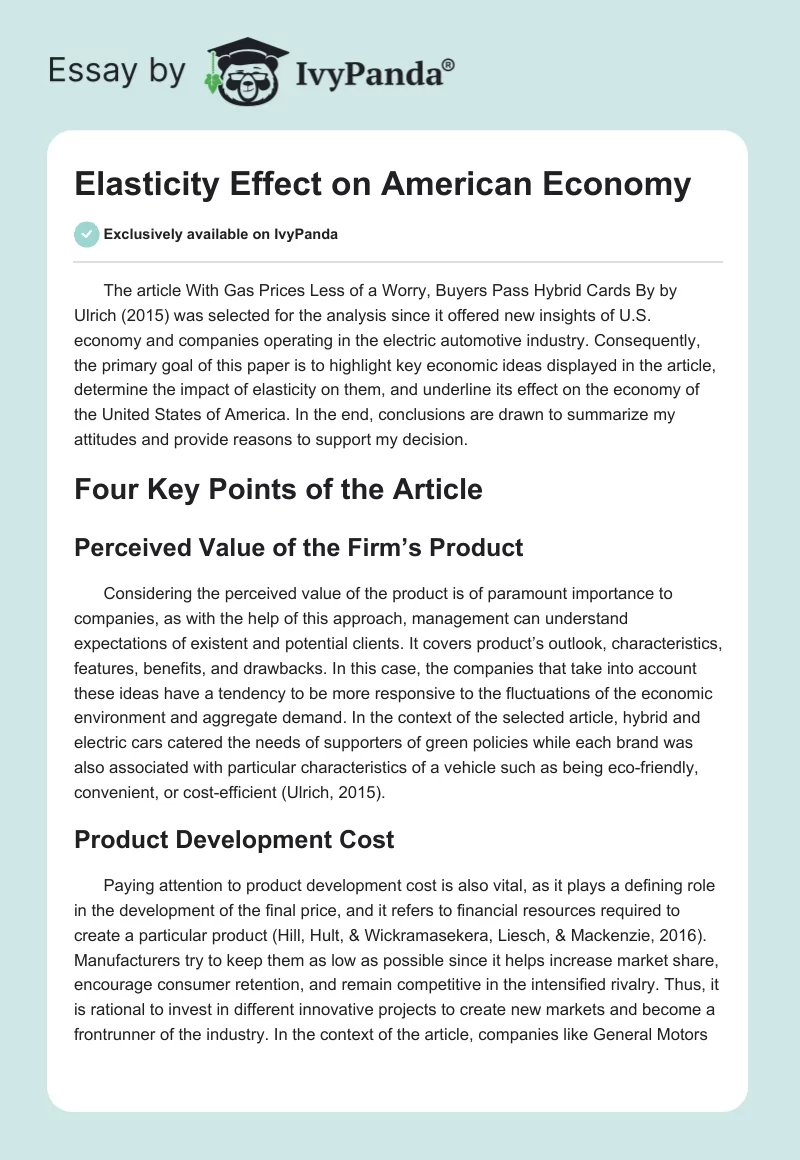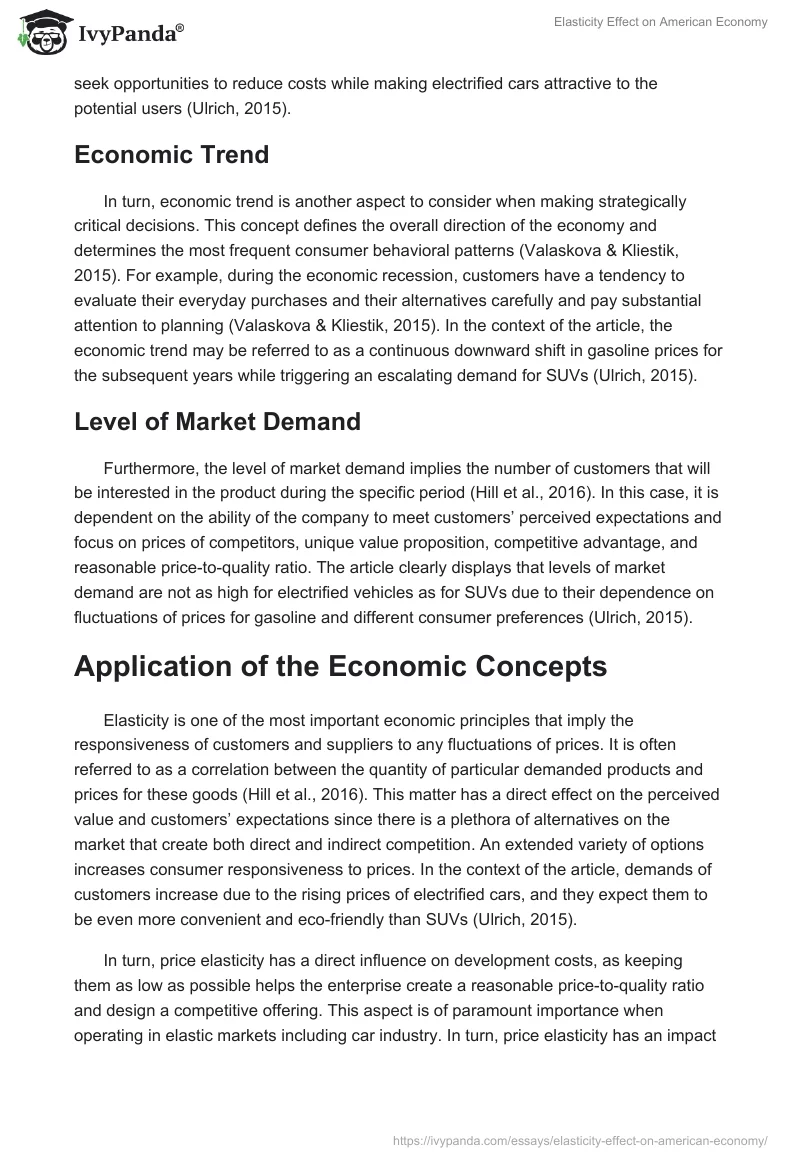The article With Gas Prices Less of a Worry, Buyers Pass Hybrid Cards By by Ulrich (2015) was selected for the analysis since it offered new insights of U.S. economy and companies operating in the electric automotive industry. Consequently, the primary goal of this paper is to highlight key economic ideas displayed in the article, determine the impact of elasticity on them, and underline its effect on the economy of the United States of America. In the end, conclusions are drawn to summarize my attitudes and provide reasons to support my decision.
Four Key Points of the Article
Perceived Value of the Firm’s Product
Considering the perceived value of the product is of paramount importance to companies, as with the help of this approach, management can understand expectations of existent and potential clients. It covers product’s outlook, characteristics, features, benefits, and drawbacks. In this case, the companies that take into account these ideas have a tendency to be more responsive to the fluctuations of the economic environment and aggregate demand. In the context of the selected article, hybrid and electric cars catered the needs of supporters of green policies while each brand was also associated with particular characteristics of a vehicle such as being eco-friendly, convenient, or cost-efficient (Ulrich, 2015).
Product Development Cost
Paying attention to product development cost is also vital, as it plays a defining role in the development of the final price, and it refers to financial resources required to create a particular product (Hill, Hult, & Wickramasekera, Liesch, & Mackenzie, 2016). Manufacturers try to keep them as low as possible since it helps increase market share, encourage consumer retention, and remain competitive in the intensified rivalry. Thus, it is rational to invest in different innovative projects to create new markets and become a frontrunner of the industry. In the context of the article, companies like General Motors seek opportunities to reduce costs while making electrified cars attractive to the potential users (Ulrich, 2015).
Economic Trend
In turn, economic trend is another aspect to consider when making strategically critical decisions. This concept defines the overall direction of the economy and determines the most frequent consumer behavioral patterns (Valaskova & Kliestik, 2015). For example, during the economic recession, customers have a tendency to evaluate their everyday purchases and their alternatives carefully and pay substantial attention to planning (Valaskova & Kliestik, 2015). In the context of the article, the economic trend may be referred to as a continuous downward shift in gasoline prices for the subsequent years while triggering an escalating demand for SUVs (Ulrich, 2015).
Level of Market Demand
Furthermore, the level of market demand implies the number of customers that will be interested in the product during the specific period (Hill et al., 2016). In this case, it is dependent on the ability of the company to meet customers’ perceived expectations and focus on prices of competitors, unique value proposition, competitive advantage, and reasonable price-to-quality ratio. The article clearly displays that levels of market demand are not as high for electrified vehicles as for SUVs due to their dependence on fluctuations of prices for gasoline and different consumer preferences (Ulrich, 2015).
Application of the Economic Concepts
Elasticity is one of the most important economic principles that imply the responsiveness of customers and suppliers to any fluctuations of prices. It is often referred to as a correlation between the quantity of particular demanded products and prices for these goods (Hill et al., 2016). This matter has a direct effect on the perceived value and customers’ expectations since there is a plethora of alternatives on the market that create both direct and indirect competition. An extended variety of options increases consumer responsiveness to prices. In the context of the article, demands of customers increase due to the rising prices of electrified cars, and they expect them to be even more convenient and eco-friendly than SUVs (Ulrich, 2015).
In turn, price elasticity has a direct influence on development costs, as keeping them as low as possible helps the enterprise create a reasonable price-to-quality ratio and design a competitive offering. This aspect is of paramount importance when operating in elastic markets including car industry. In turn, price elasticity has an impact on economic trends, as some goods become more popular than other ones due to their low prices, effective value proposition, and compliance with consumer needs.
The inability to satisfy the rising expectations along with constantly decreasing prices for gasoline explains a downward shift of electric cars from 3.4% to 2.7% of the total market share (Ulrich, 2015). Based on the factors highlighted above, the price elasticity of demand has a direct impact on the overall market level since changes in prices affect consumer behavior and underline their rationale for choosing SUVs.
Effect of the Concept on the U.S. Economy
As it was indicated in the content of Question 2, the price elasticity of demand was one of the essential economic concepts that interfered with other business spheres. Generally speaking, this matter can have an effect on the U.S. economy in diverse ways. For example, a high level of elasticity creates competitive environment while enlarging the market size and leading to innovation. A combination of these factors not only positively affects companies’ development, budget distribution, and financial prosperity but also has an advantageous influence on the national economy.
For example, maintaining these conditions and increasing markets for particular products make the U.S. attractive to foreign investors, and this trend is positive for the financial stability of the companies and GDP (Rahaman & Chakraborty, 2015).
In turn, a high level of competition triggered by price elasticity of demand requires enterprises adjust their strategies to become market leaders. This continuous rivalry causes an upward shift in GDP due to substantial economic activity and positive changes in revenues of the market players. Overall, maintaining price elasticity within a reasonable value range will have an advantageous impact on the economy while at the same time, with the help of this economic concept, the government of the United States of America can control the prices for commodities (inelastic goods).
Conclusion
As it was indicated herein, the article showed that the demand for electric vehicles was dependent not only on consumer preferences and expectations but also on changes in prices for gasoline (Ulrich, 2015). I entirely agree with this idea since perceived value only defines the main features of cars that have to be improved. For example, customers expect electric automobiles to be more convenient regarding charging and have a faster return on investment (Ulrich, 2015).
Nonetheless, the companies operating in this segment have to monitor fluctuations of gasoline values. For example, it is rational that low fuel prices will attract more users to the car market, as a purchase of automobile will be associated with lower maintenance costs. This matter explains escalating popularity of SUVs displayed in the article (Ulrich, 2015). Nonetheless, the electric car producers including Toyota and General Motors stay positive and do not consider these aspects of paramount importance. I agree with this position since constantly making improvements to their electric vehicles and rising environmental concerns will cause an increase in demand for hybrid and electric cars in the recent future, as they are proven to be more sustainable and eco-friendly (Helmers & Marx, 2012).
References
Helmers, E., & Marx, P. (2012). Electric cars: Technical characteristics and environmental impacts. Environmental Sciences Europe, 24(1), 14.
Hill, C., Hult, T., & Wickramasekera, R., Liesch, P., & Mackenzie, K. (2016). Global business today: Asia-Pacific Perspective. Melbourne, Australia: McGraw Hill Australia.
Rahaman, A., & Chakraborty, S. (2015). Effects of foreign direct investment on GDP: Empirical evidence from developing country. Advances in Economics and Business, 3(12), 587-592.
Ulrich, L. (2015). With gas prices less of a worry, buyers pass hybrid cards by. The New York Times. Web.
Valaskova, K., & Kliestik, T. (2015). Behavioral reactions of consumers to economic recession. Business: Theory and Practice, 16(3), 290-303.


